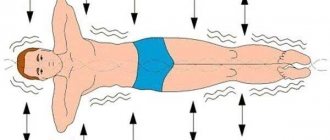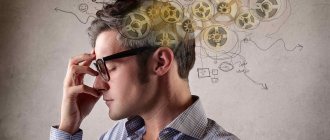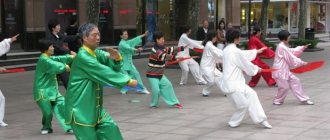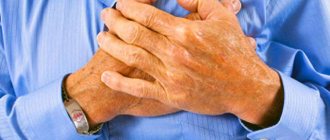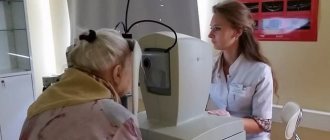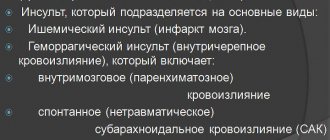Vascular dystonia is a common blood circulation disorder, the causes of which may be related to both genetic predisposition and external factors. Stress, lack of physical activity, smoking, consequences of past illnesses - all this leads to the fact that the blood vessels are in increased tone. The narrowing of the lumen leads to impaired blood supply and increased blood pressure, especially if there is a diagnosis of “neurocirculatory dystonia,” which significantly aggravates the course of these processes. It is not so much pharmaceutical drugs that can help restore proper blood circulation, but an active lifestyle and simple exercises for blood vessels.
Capillary training is a prerequisite for improving the vascular system
The smallest blood vessels are capillaries.
They are responsible for the life of every cell of the body, delivering nutrients to it and freeing it from decay products. Capillaries permeate the entire human body, their total “length” is at least 60 thousand kilometers. If an obstacle is encountered in the path of blood flow in the form of an extremely narrowed vessel, then in the nearest cells there will be an accumulation of toxic decay products that will not be eliminated in a timely manner. This will lead to disease not only in the cardiovascular system, but also in other vital organs. The Japanese scientist and healer Katsuzo Nishi called blood the “river of life” and created an entire system for healing the body through training capillaries and exercises to strengthen blood vessels:
- The simplest but most effective technique that can improve the condition of capillaries and blood circulation is vibration exercise. You need to do it in the morning, without getting out of bed. Raising your legs and arms up, you should simply shake them finely and frequently for 1.5 - 2 minutes. In addition to a kind of vibration massage of the capillaries, there is also a redistribution of lymphatic fluid, which helps cleanse the body of toxins and waste.
- Another exercise from Nisha’s arsenal is “Golden Fish”. Lying on a flat bed, you need to put your hands under your neck at the level of the fourth cervical vertebra, pull your toes towards you, and, straining very hard, reproduce small vibrating movements with your whole body, like a fish. This exercise helps get rid of excessive tone of the nerves located in the spine and promotes active blood circulation.
You need to train capillary vessels regularly, repeating the exercises twice a day - in the morning, after waking up, and in the evening.
Video: a set of exercises according to the Nishi system
How to get rid of cerebral vascular spasms
Poor circulation and vascular dystonia are the reasons why cerebral vascular spasms occur. The clinical manifestations of spastic attacks are familiar to many. This
- Regularly occurring headaches, dizziness, changes in blood pressure;
- Nausea, disturbances in speech and coordination of movements;
- Tinnitus, memory impairment;
- Fatigue and a sharp decrease in performance.
Vasospasm can be triggered by a stressful situation, changes in atmospheric pressure, or chronic diseases of the spine (osteochondrosis, for example). To minimize the risk of spasms, it is necessary to strengthen the blood vessels of the brain. This will be helped by a healthy diet, adherence to a work and rest schedule, medicinal herbs and special exercises.
To improve blood supply to the brain, daily gymnastics should include movements that require changing the position of the head - bending from side to side, rotating the head, flips and somersaults. When performing exercises, you must monitor your breathing and perform head movements smoothly, without jerking. If unpleasant sensations, darkening in the eyes, or severe dizziness occur, gymnastics should be interrupted and resumed after a short rest, reducing the intensity of movements.
A set of exercises to improve blood flow in the brain
- Performed standing, feet shoulder-width apart. Rotate your head clockwise and back for 2-3 minutes.
- I.P. - Same. Raise your hands up, interlace your fingers. Lean forward while performing “chopping wood” movements. Repeat 8 times.
- I.P. - Same. Swing your legs alternately: the left leg goes to the right hand, the right leg goes to the left hand.
- I.P. - the same, knees slightly bent. Stretch your arms to the sides and perform asynchronous rotations: rotate your left hand forward, your right hand back. Exercise improves memory and speed of thinking.
- I.P. – lying on your back, legs and arms extended along the body. Raise your legs straight as high as possible, supporting your lower back with your hands. Perform the “Birch” stand for up to 5 minutes.
Excellent gymnastics for the blood vessels of the brain is dancing. By performing dance steps, a person trains coordination, the blood is enriched with oxygen, and its circulation improves. Brain vessels become more elastic, their tone decreases. In addition, dancing is a great way to relieve emotional tension and get rid of stress. And this is a very significant factor in the improvement of brain vessels.
Video: a simple exercise to strengthen weak blood vessels
The healthiest foods for the human brain
The brain is one of the most complex organs of the human body. Without it, neither mental work nor normal physiology is possible. Its functioning requires a variety of amino acids, polyunsaturated fats Omega 3 and Omega 6, vitamins (especially vitamins E and C), water and many other substances and compounds.
The most beneficial foods for the brain
Sea fish and seafood are an essential component of the diet, aimed at improving the functioning of the brain and the entire nervous system. Phosphorus, iodine, minerals, Omega-3 fatty acids help the brain maintain efficiency and youth. They affect the reduction of the level of “bad” cholesterol, cleansing the walls of blood vessels from fatty plaques, and actively saturating brain cells with oxygen and nutrients.
Eggs. The yolk of an egg contains choline, which nourishes brain cells and neurons, without which they cannot form and exist. If you eat eggs regularly, it is enough to eat 1-2 eggs a day.
Milk. Milk is necessary for the brain because it contains tryptophan, a substance that is a source for the synthesis of serotonin, the hormone of joy. In addition, the antioxidant glutathione, which researchers recently discovered in milk, improves neuronal function and helps maintain sanity into old age.
Cereals. Oats, wheat, barley, brown rice and bran from them contain a lot of folic acid and thiamine, that is, vitamin B6. Thus, porridge and whole grain bread are useful not only as a means of improving metabolism, but also as an excellent stimulator of blood circulation and improvement of brain activity.
Nuts. Seeds and nuts are used both as an independent snack and as an additional ingredient in dishes. They contain everything that brain cells need: vitamins E and B; folic acid; Omega-3 and Omega-6 fatty acids, etc., minerals, including magnesium and potassium. Nuts such as almonds, walnuts, cashews, peanuts, hazelnuts, pecans, and all types of seeds nourish the brain, provide a lot of energy, improve memory, elevate mood, and even reduce signs of depression.
Green and leafy vegetables, herbs. Greens contain so many vitamins important for mental activity that even a single loading dose can help: remember or remember a large amount of valuable information; increase the productivity of mental activity; relieve fatigue. Greens owe these results to a large amount of B vitamins and folic acid.
Berries. Vitamins, sugars, fiber, antioxidants, flavonoids from berries help with heavy mental stress, improve coordination and memory, preserve youth and increase cell performance.
Dried fruits. The rich vitamin and mineral composition makes dried fruits an essential product for those who want their head to work quickly and well. Dried apricots, raisins, prunes, figs, dates and other dried fruits and berries reduce the level of “bad” cholesterol in the blood, cleanse the blood vessels of the brain from cholesterol plaques, improve memory and concentration, and help maintain good coordination.
Honey. Honey is a recognized healer of the cardiovascular and nervous system. With constant mental work, it is definitely needed in the diet as a means of cleansing the blood and blood vessels from “bad” cholesterol and improving cerebral circulation.
Tea. Both black and green teas contain catechins. These unique substances help improve brain activity, remember information well, relax, and restore strength faster. It is better to drink tea in the morning and afternoon.
Turmeric. Turmeric is useful for the brain because it can relieve inflammation in brain tissue, restore neurons, destroy sodium benzoate, which interferes with connections between brain cells, act as an antioxidant that protects cells from aging, and give a positive mood due to the production of the hormones dopamine and serotonin.
Ginger. A spice with a pungent taste and fresh aroma is very beneficial for the heart, blood vessels and brain cells. Ginger is used as a blood thinner, improves cerebral circulation, and with regular use significantly improves memory, preventing the development of Alzheimer's and Parkinson's diseases.
Lemon. The value of lemon for the brain is associated primarily with its high content of vitamin C, potassium, magnesium and other minerals. Lemon helps cleanse blood vessels of cholesterol build-ups, prevent fatigue and relieve stress.
Plain water. The brain cannot function normally without sufficient fluid in the body. Often, a feeling of chronic fatigue and drowsiness are signs of a lack of moisture in the body. The best way to replenish fluid reserves and thereby protect the brain from dehydration is to drink regular drinking water: it is best absorbed without carrying additional calories, such as fruit juice.
Strengthening the blood vessels of the legs - a confident step into a healthy life
The “payback” for walking upright is the increased load experienced by the veins of the legs. Weakness of the leg veins can lead to stagnation of blood, and as a result, serious damage to the veins. There is no better way to prevent vascular diseases in the legs than movement. To reduce the load on the lower limbs, it is more effective to perform exercises in water. Swimming, water aerobics, taking balneological baths and even simply pouring cool water on your feet stimulates blood circulation and causes the blood vessels in your legs to contract and unclench with greater intensity. Such regular exercise for the vessels helps to strengthen them and makes the walls of the leg veins more elastic.
A set of exercises aimed at strengthening the blood vessels of the legs
- I.P. – standing on the floor, feet wider than shoulders. Bend forward and down, reaching the floor surface with your fingers. When performing bends, keep your legs straight.
- I.P. - sitting on the floor. Spread your legs as wide as possible, fold your arms at chest level, leaning forward to reach the floor with bent arms. Make sure your legs remain straight. After every 8-10 bends, take a minute break.
- I.P. - on my knees. Stretch your arms to the sides and start walking on your knees back and forth. If you are tired, lie down on the floor and restore your breathing.
Exercises to prevent venous insufficiency of the legs and varicose veins
Slow jogging is useful for improving the health of blood vessels in the legs. If you approach training without excessive fanaticism, dosing the intensity of the load and the duration of runs, then the benefits will be undoubted. Contraindications for training may include:
- Eating shortly before a run;
- Noise or buzzing in the ears;
- Weakness in the legs;
- Severely reduced blood pressure.
If you experience excessive fatigue or discomfort while jogging, it is better to stop, do a few breathing exercises to restore your breathing, and start walking. The intensity of training should be increased only when the body fully adapts to the increased physical activity.
Video: preventative exercises for legs
Symptoms of weakened blood vessels
If similar symptoms are detected, you need to pay close attention to the condition of the blood vessels:
- Fainting and dizziness;
- Throbbing pain in the back of the head or temples, tinnitus;
- Cold and swollen feet;
- Intolerance to hot weather;
- Dependency on weather;
- Depression, insomnia, fatigue;
- Shortness of breath, tachycardia, constantly changing pressure;
- Hematomas even with a small impact;
- Changeable temperature;
- Nosebleeds;
- Spider veins and pinpoint hemorrhages on the skin;
- Tingling, pain and bruising on the eyeball.
Healthy neck vessels are the key to good health
The neck is an extremely important part of the human body. It is here that the vital arteries are concentrated, through which the blood supply to the brain and spinal column occurs. Weakened neck muscles force a person to constantly strain to keep their head and back straight. This tension leads to compression of blood vessels and pinching of nerve endings. Hence - impaired blood circulation, headaches, high blood pressure and other unpleasant symptoms.
By strengthening the neck muscles, you can restore the blood vessels in the neck and thereby get rid of ailments. Among the exercises, the main place is occupied by turns, tilts and rotations of the head. All movements should be performed extremely smoothly, not forgetting to monitor proper breathing. Chinese gymnastics, where there are no sudden and active movements, gives good results. Exercises for neck vessels and muscle strengthening can be performed both at home and at work - you do not need a specially equipped place for this.
Exercises to strengthen neck muscles
- Stand against a wall, trying to keep all parts of your body pressed tightly against the vertical surface. As you inhale, push yourself into the wall with all your might, tensing your neck muscles as much as possible. Hold your breath and maintain this position for 5-6 seconds.
- Sitting on a chair, you need to place your palm on your forehead and press hard, forcing your head to lean back. At the same time, straining your neck, you should resist the forward movement of your head. Such a “confrontation” with maximum tension should be held for 5-7 seconds, while breathing should be suspended. After the time has passed, exhale and rest for 10-12 seconds. Repeat movements 3 to 7 times.
- Similar movements are made with the head tilted forward and to the sides. This gymnastics is good because you can perform 1-2 exercises every hour during the day - this is extremely useful for dilating the blood vessels of the neck and brain.
- Slowly rotate your head in a semicircle, from one shoulder to the other, holding it in extreme positions. Repeat 8-12 times, gradually increasing the amplitude.
Video: exercises useful for VSD
How to train the heart and blood vessels?
In order to keep the blood vessels and heart in good condition for a long time, you need to pay maximum attention to their regular training. This is especially true for older people who, due to age, have reduced physical activity. A sufficient amount of oxygen and feasible physical exercise - this should not be forgotten by older people.
Training the heart and blood vessels should begin in the morning, immediately after waking up. Rotating your hands and feet is an exercise that will make your blood flow “wake up” and the blood vessels will dilate. Bends, squats and turns of the body must be performed while constantly monitoring the heart rate. If the pulse of an untrained person is within 90-100 beats per minute, then his heart still does not receive enough oxygen and blood. As the degree of general physical activity increases, the heart rate also increases. Accordingly, the heart works more efficiently and receives a sufficient amount of blood due to the good functioning of the aorta.
Several exercises for the heart and blood vessels
- Rise on your toes and walk with your knees raised very high.
- The legs are at shoulder width. Hands rise upward, clasping hands together. When the body tilts to the right, the right leg is moved to the right. Try to perform the tilt as deeply as possible. Repeat the same movements to the left side. Perform 8-9 times, remembering to control your breathing.
- Extend your arms to the sides and rhythmically clap your palms on the opposite shoulder. Right hand - left shoulder, and vice versa. Keep your body straight. Increase repetitions and tempo in the absence of unpleasant sensations in the heart area up to 50 times.
- Place your arms along your body, legs pressed tightly against each other. Make a full circle with your hands: back - up - forward. First carry out the rotation cycle in one direction, then change the direction to the opposite. Repetitions – from 10 to 50.
- Lying on your back, you need to raise your knees bent at an angle of 90° and imitate the movements of riding a bicycle. Do not hold your breath.
- While in a lying position, raise your outstretched legs to a height of 30-40 cm and make cross-shaped movements. Repeat 20-25 times.
Swimming, cycling, cardio exercises, and walking up the stairs help to actively train your heart. Just one thing should not be forgotten: the load should increase gradually. The main thing when doing exercises is not their quantity and intensity, but regularity.
A strict cycle must be observed: load and relaxation. Then the muscle fibers of the heart will increase, the heart muscle and blood vessels will strengthen, and the benefits of training will become obvious.
Video: exercises to improve the cardiovascular system through muscles
Atherosclerosis of cerebral vessels (cerebral atherosclerosis) - symptoms and treatment
Treatment of cerebral atherosclerosis consists of influencing three groups of factors:
- Local factors, which include narrowing of the arteries of the brain by atherosclerotic plaques.
- Systemic factors, such as sudden changes in systemic blood pressure.
- Provoking factors, such as traumatic situations and infections [9].
Treatment of arterial hypertension
Features of the treatment of hypertension in patients with cerebral atherosclerosis:
- it is necessary to control even a slight increase in blood pressure (BP) and strive to reduce it in the morning - the pressure rises an hour before waking up and remains elevated for 4-5 hours after it;
- treatment should be ongoing, and not just when your health worsens;
- avoid sudden changes in pressure; for this it is better to use long-acting antihypertensive drugs with a 24-hour effect and, if necessary, combine drugs from different groups;
- fight hypertensive crises - find out the cause, select drugs for prevention, adequately eliminate crises, avoiding a sharp and excessive decrease in pressure.
When taking antihypertensive drugs, you need to regularly monitor changes in blood pressure. It is measured after waking up, before going to bed and during the day if symptoms of the disease appear. It is recommended to record the measurement results in a diary.
When monitoring blood pressure, it is important to consider how much blood is supplied to the brain. Signs of poor blood supply include a history of strokes and transient ischemic attacks, narrowing of the brachiocephalic arteries and the presence of foci of leukoaraiosis (damage to the deep white matter) on MRI, cognitive impairment, left ventricular hypertrophy and coronary heart disease. In order not to aggravate chronic cerebral ischemia and to avoid circulatory disorders, the pressure in such patients is reduced gradually, which may take from a month to six months.
The target level of systolic blood pressure differs for different groups of patients:
- in young and middle-aged people without severe atherosclerosis, it is 130–140 mm Hg. Art.;
- in elderly and senile patients with transient ischemic attacks or a history of stroke - 140–150 mm Hg. Art.;
- in patients with third-degree hypertension with severe atherosclerosis - 150–160 mm Hg. Art.
Systolic blood pressure measures the pressure on the walls of blood vessels at the moment when the heart contracts and pushes out blood. On the tonometer this is the first or top number.
Basic therapy for lowering blood pressure includes the following groups of drugs:
- angiotensin-converting enzyme inhibitors (ACEIs) - Ramipril, Lisinopril, Perindopril, etc.;
- sartans - Telmisartan, Candesartan, etc.;
- beta blockers - Bisoprolol, Metoprolol, Nebivolol;
- calcium antagonists - Amlodipine, Lercanidipine;
- diuretics - Chlorthalidone, Indapamide, thiazides.
Regulation of lipid metabolism
In the initial stages of atherosclerosis, cholesterol is reduced through diet.
You should eat less:
- easily digestible carbohydrates - sugar, sweets, jam, white bread, cakes, etc.;
- animal fats - butter and fatty meats;
- table salt - less than 5 g per day, preferably 2-3 g;
- pickles and smoked meats;
- fried foods.
It is recommended to include in the diet:
- fresh vegetables and fruits (for example, kiwi [15]);
- dairy products;
- barley, soybeans and almonds;
- wholemeal bread;
- vegetable or olive oil.
If atherosclerosis progresses, statins are prescribed - drugs that lower cholesterol levels (Atorvastatin, Rosuvastatin, Simvastatin). The doctor selects their dosages individually. At the same time, it is important not only to monitor cholesterol levels, but also to monitor liver function, i.e., evaluate the effectiveness and safety of the drug at the prescribed dose.
Target LDL levels:
- with extreme cardiovascular risk - up to 1.0 mmol/l;
- with high and very high cardiovascular risk - up to 1.8 and 1.4 mmol/l;
- with moderate risk and low cardiovascular risk - up to 2.6 and 3.0 mmol/l [6].
Cardiovascular risk increases with diabetes mellitus, chronic kidney disease, and heart and vascular diseases. The risk level is considered extreme if cardiovascular diseases have already developed against the background of atherosclerosis, the patient takes statins at the maximum tolerated dose, but despite this, he suffered two severe attacks (for example, a stroke) over the past two years.
Taking statins allows you to strengthen the plaque cover, reduce the likelihood of its rupture, thrombosis and complete blockage of the vessel. A beneficial effect is often observed already in the first weeks of treatment. During this period, it is associated with improved blood flow, normalization of the blood coagulation system and the production of nitric oxide, which has a beneficial effect on the vascular wall.
When triglycerides (TG) increase, fibrates are prescribed: Clofibrate, Bezafibrate, Fenofibrate. They can be used either together with statins or separately. They are often used for diabetes mellitus, in which TGs are often elevated. For high TG levels in combination with gout, Fenofibrate is preferable - it reduces the content of uric acid, which damages the vascular wall.
To enhance the effect of statins, as well as in case of intolerance to them, the drug Ezetimibe is used, which suppresses the absorption of cholesterol in the intestine. You can also effectively and safely reduce cholesterol levels with the help of monoclonal antibodies - inhibitors of the PCSK9 enzyme (Evolocumab, Alirocumab).
Antiplatelet and anticoagulant therapy
To prevent the formation of blood clots and blockage of blood vessels, antiplatelet agents are prescribed: Aspirin, Clopidogrel, Prasugrel, Ticagrelor, Dipyridamole. They are especially recommended for women over 55–65 years of age who suffer from hypertension, diabetes mellitus, hyperlipidemia, as well as patients with carotid artery stenosis. These drugs are taken for life.
In case of cerebral atherosclerosis in combination with atrial fibrillation, it is recommended to take anticoagulants for the prevention of thrombosis and ischemic strokes: Dabigatran, Rivaroxaban, Apixaban. These drugs thin the blood more than antiplatelet agents. They are also accepted for life.
For the prevention of stroke, myocardial infarction and acute limb ischemia with coronary artery disease or lesions of peripheral arteries, Rivaroxaban is used in a reduced dosage in combination with Aspirin.
Symptomatic therapy
Symptomatic therapy slows down the development of cognitive disorders and dementia, reduces the severity of existing disorders, which improves the quality of life of patients and their relatives.
For the treatment of cerebrovascular insufficiency the following are used:
- Vasoactive drugs - Cavinton, Vasobral, Bilobil, Tanakan, Sermion. They improve microcirculation and are taken in courses 1–2 times a year.
- Cortexin, Cerebrolysin - have a positive effect on metabolic processes and the plasticity of brain cells. Plasticity allows neurons to recover and create new synaptic connections. The medications are taken in a course of 1–2 months.
- Drugs with neurometabolic effects - Citicoline, Ginkgo biloba, Piracetam, Pantogam active. They increase the brain’s resistance to hypoxia and the effects of toxic substances, and help nerve cells recover. They are taken for 1–2 months.
- Antioxidants - Cytoflavin, coenzyme Q, L-carnitine (succinic acid derivatives). They improve the transmission of nerve impulses, the plasticity of neuronal membranes, the functioning of receptors, blood flow in the vessels of the brain and metabolic processes. They are also taken for 1–2 months.
In addition to drug treatment, patients will benefit from physical activity. Walking and moderate exercise have a beneficial effect on the entire body, including the cognitive sphere. It is also important for patients to adhere to a diet: eat less fat, easily digestible carbohydrates, salt, and more foods containing antioxidants.
Gymnastics for hypertension
{banner_banstat9}
Vascular training is especially important for hypertension. High blood pressure is often due to the fact that the walls of blood vessels lose their ability to relax and blood has difficulty “pushing” through the narrowed vessels. Atherosclerotic changes in the arteries – cholesterol plaques on their walls – add to problems with high blood pressure. If you do not make any efforts to train slow-moving vessels, a chronic increase in pressure can lead to serious consequences.
Important!
If you have hypertension, you should not perform bending, sudden swings of arms and legs, or all exercises that ensure blood flow to the head. You should not hold your breath while exerting muscle force - this can lead to an even greater increase in pressure.
Exercises for hypertensive patients
- Warm-up: walking around the room, with smooth turns of the body. The arms and legs perform non-sudden movements - short swings, bending, half-squats. When walking, you can perform circular movements with your pelvis. Duration – 5 minutes.
- Sitting on a chair, place your feet at a distance of 30-40 cm, raise your arms up. Lowering your arms down and moving them behind your back, bend forward towards your knees. At the same time, you need to keep your head straight, your gaze directed forward.
- Without rising from the chair, extend your arms straight to the sides, and at the same time raise your leg bent at the knee to your chest. At the same time, your arms are brought together in front of you, helping to hold the raised leg. Perform alternately with the right and left foot, 6-8 times.
- Hands to the sides - inhale, as you exhale, place your hands on your waist and tilt your body to the right. Repeat with a tilt to the left. You can perform the exercise both sitting and standing.
- Extend your arms to the sides, keep your body straight. Move your right leg clearly to the right, hold it at a height of 30-40 cm. Repeat the same movements with your left leg.
Video: exercises to normalize blood pressure
{banner_banstat10}
Breathing exercises
Breathing exercises greatly help to enrich the blood with oxygen, which is a natural vasodilator. There are several practices of healing breathing exercises - Chinese Qigong gymnastics, Strelnikova breathing exercises, Buteyko deep breathing method, yoga. With all the variety of technologies, the principles of breathing are used with a great degree of similarity: a deep short breath through the nose, holding the breath and an almost imperceptible natural exit through the mouth.
During yogic breathing, inhalation is accompanied by protrusion of the abdomen, followed by exhalation after a pause - the abdomen is drawn in as much as possible. Several breathing exercises can reduce blood pressure and normalize vascular function. And mastering breathing practices will help you forget about hypertension for many years.
Video: breathing exercises for hypertensive patients
How to strengthen blood vessels?
Most doctors suggest that patients not only take medications, but also change their lifestyle. It is worth giving up bad habits (smoking and alcohol), changing your physical activity regime (try not to sit still, but also not overloading yourself with exercise), resting, avoiding nervous shock and sticking to proper nutrition.
Medicines are the main way to correct the condition of blood vessels. With proper treatment, you can achieve good results in strengthening the walls of blood vessels or reduce the risk of problems with them in the future.
Therapeutic exercise after heart attacks and strokes
Exercise not only helps prevent cardiovascular disease. Rehabilitation therapy in the post-infarction period involves the mandatory introduction of physical therapy exercises. The first complex of exercise therapy is prescribed to be performed while still in the hospital, under the supervision of a doctor. But even after discharge, the patient should perform special exercises daily, alternating between feasible exercise and relaxation, for at least half an hour. To restore the myocardium, a full supply of blood and nutrients is required, and this requires feasible physical activity.
Exercises on a chair, consisting of alternately raising and lowering the legs and arms, are performed at a leisurely pace, with strict adherence to the rhythm of breathing. Walking in one place, bending to the right and left, swinging your legs - these exercises should be done while controlling your pulse. The heart rate should not rise above 120 beats per minute.
A stroke can also be compensated by using massage and exercise therapy. To restore the body's lost ability to move, it is necessary to exercise systematically and diligently. The first exercises will have to be done with an assistant, but after some time, the patient will be able to perform the complex selected by the doctor independently. During physical therapy after a stroke, it is important to avoid overwork and excessive stress. Regularity and systematicity in exercise therapy classes can restore the joy of movement.
